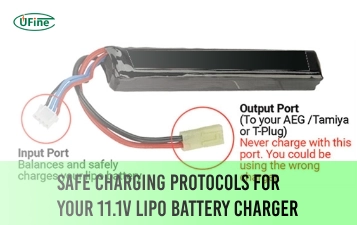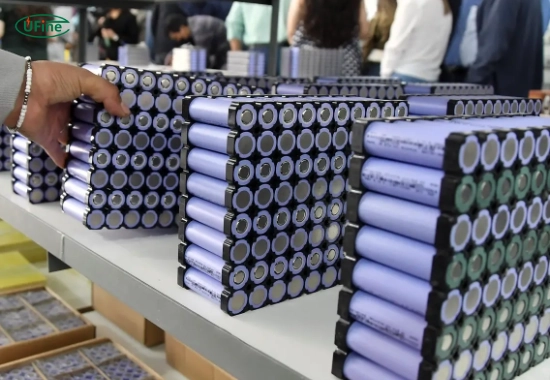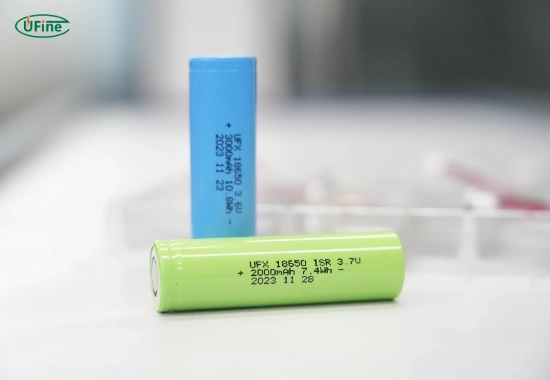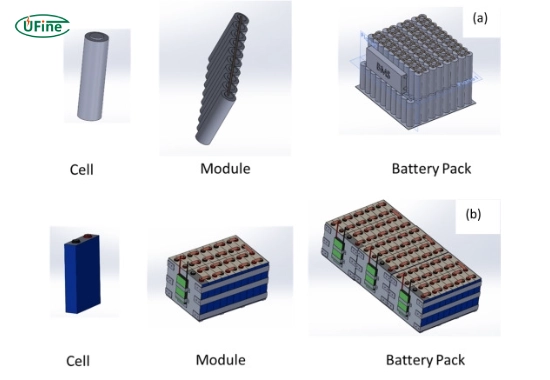Battery Array vs. Single Battery: Which Is Right for Your Energy Needs? Choosing the right battery setup can significantly impact performance, cost, and flexibility. Whether you’re powering a home, an electric vehicle, or a backup system, understanding the differences between a battery array and a single battery is key. This article explains how each option works, its advantages, and which fits your energy needs best.
Part 1. What is a battery array?
A battery array is a group of batteries connected to work as one system. Multiple batteries join forces to deliver higher capacity and better performance than a single battery could provide on its own. These arrays are built by connecting batteries in series, parallel, or a mix of both.
In a series connection, the voltage adds up while the capacity stays the same. In a parallel connection, the capacity increases while the voltage remains constant. Many systems use a combination of these connections to fine-tune both voltage and capacity.
Battery arrays are commonly used in larger energy systems such as solar installations, electric vehicles, and backup power setups. They offer the benefits of scalability and redundancy—if one battery fails, the rest can often keep the system running. With a battery array, you can start small and expand as your energy needs grow.
Part 2. What is a single battery?
A single battery is an individual energy storage unit. It operates on its own and is typically used for smaller devices or systems that do not require a large amount of stored energy. Single batteries are found in everyday items like remote controls, flashlights, and portable electronics.
The simplicity of a single battery means that it is easy to install and maintain. However, its energy storage capacity is limited by its design. Single batteries are ideal when space is tight, or energy demand is low. They usually come in standard sizes and are less complex than battery arrays.
Part 3. How do battery arrays work?
Battery arrays combine multiple battery units to create a robust energy storage system. Here’s how they typically work:
- Series Connection: When batteries are connected in series, their voltages increase. For example, four 12-volt batteries connected in series will produce 48 volts. However, the overall capacity (measured in ampere-hours or Ah) remains that of one battery.
- Parallel Connection: In a parallel connection, the capacities increase while the voltage stays the same. For example, connecting four 12-volt batteries in parallel keeps the voltage at 12 volts. Still, the total capacity becomes four times that of a single battery.
- Hybrid Configurations: Many battery arrays use a mix of series and parallel connections. This allows designers to tailor the variety to meet specific voltage and capacity needs.
These configurations provide flexibility. Mixing connection types allows you to adjust your energy system to handle higher loads or deliver backup power for longer periods. The design of a battery array often includes additional features, such as battery management systems (BMS) that monitor the health and balance of each battery.
Part 4. How do single batteries work?
A single battery converts stored chemical energy into electrical energy. When a device is connected to the battery, a chemical reaction releases electrons, which travel through the circuit and power the device.
Because of their straightforward design, single batteries are simple and reliable. They have built-in protection circuits to prevent overcharging, deep discharging, and short circuits. This simplicity makes them easy to use, especially in small devices or systems without high capacity.
Because a single battery does not combine power with other cells, its overall performance is determined solely by its capacity and voltage rating. Despite this limitation, single batteries are effective in many applications, from small consumer electronics to emergency backup systems.
Part 5. What are the advantages of battery arrays?
- High Capacity: Linking multiple batteries significantly increases the energy storage capacity. This is essential for systems that power homes, electric vehicles, or industrial applications.
- Scalability: A battery array can start with a few batteries and add more over time, making it very adaptable to changing energy needs.
- Redundancy: In an array, if one battery fails, the others can continue to supply power, improving system reliability.
- Custom Configuration: Battery arrays allow you to set up the system to match your desired voltage and current, allowing you to design the system to suit your application.
- Enhanced Efficiency: By balancing the load across multiple batteries, you can improve the overall efficiency and extend the lifespan of each battery.
For example, a typical home solar installation might use a battery array to store energy during the day and provide backup power at night. The ability to expand the array means that homeowners can increase their storage capacity as their energy needs grow.
Part 6. What are the advantages of single batteries?
- Ease of Installation: The wiring and setup are much more straightforward, with only one battery. This makes it ideal for beginners and low-power applications.
- Lower Cost: Purchasing one battery is generally more cost-effective than buying a complete array. It reduces both initial costs and ongoing maintenance expenses.
- Compact Size: Single batteries are typically smaller and lighter, making them suitable for devices with limited space.
- Simple Maintenance: With no need for complex balancing or management systems, maintaining a single battery is straightforward.
- Predictable Performance: The output is consistent with the battery’s rated specifications, making it easier to plan energy usage.
These features make single batteries perfect for portable electronics, small backup systems, and applications where simplicity and cost are critical.
Part 7. What factors should you consider when choosing your battery system?
- Energy Requirements: Estimate the total energy you need. Large systems with high demands usually benefit from a battery array.
- Space Availability: Consider the physical space where the batteries will be installed. Single batteries take up less space.
- Budget: Look at both the initial purchase cost and the long-term maintenance expenses. Arrays often require a higher upfront investment.
- Scalability Needs: If you expect your energy needs to grow, a battery array allows you to add more batteries later.
- Maintenance Complexity: Battery arrays require more careful monitoring and balancing, while single batteries are easier to maintain.
- Environmental Conditions: Temperature, humidity, and other factors can affect battery performance. Choose a system that is robust enough for your environment.
Assessing these factors will help you select the best performance, cost efficiency, and scalability system for your specific situation.
Part 8. Comparing battery arrays and single batteries
| Feature | Battery Array | Single Battery |
|---|---|---|
| Capacity | High capacity. Typical arrays: 200Ah to 1000Ah total. | Lower capacity. Typical range: 50Ah to 200Ah per unit. |
| Scalability | Easily scalable. Add more cells as needed. | Fixed size. No option to add more cells without replacement. |
| Voltage | Configurable. Common setups include 48V systems using four 12V cells. | Standard voltage (often 12V in many devices). |
| Redundancy | Multiple cells provide backup if one fails. | No redundancy. Failure of one unit stops the system. |
| Installation | More complex wiring requires careful design and management. | Simple installation: Easy to set up with basic wiring. |
| Cost | Higher initial cost due to multiple batteries and extra hardware. | Lower cost. One battery is more affordable for small needs. |
| Maintenance | Requires regular balancing and monitoring. | Easier maintenance with fewer parts to monitor. |
| Size & Weight | Takes up more space. Larger footprint and higher weight. | Compact and lightweight. Suitable for tight spaces. |
| Applications | Used in home solar, electric vehicles, grid storage, and industrial use. | Used in portable devices, small backup systems, and gadgets. |
Part 9. How to optimize your energy system with battery arrays?
- Proper Configuration: Connect the batteries in the optimal series-parallel layout to meet your voltage and capacity needs.
- Regular Maintenance: Check each battery for signs of wear or imbalance. Regular inspections can prevent small issues from becoming major problems.
- Temperature Control: Install proper cooling or ventilation systems to maintain optimal operating temperatures. Batteries work best when they are not too hot or too cold.
- Battery Balancing: Use a battery management system (BMS) to ensure that all cells charge and discharge evenly. This prolongs battery life.
- Monitoring Software: Implement real-time tools that track performance metrics like voltage, current, and temperature.
- High-Quality Components: Invest in reputable brands that offer reliable batteries and accessories. High-quality components can lead to better efficiency and longer system life.
These steps will help you build a robust battery array that delivers reliable, long-lasting power for large-scale applications.
Part 10. How to optimize your energy system with single batteries?
- Right Sizing: Choose a battery that fits your specific energy needs. An undersized battery will require frequent recharging, while an oversized battery may not be cost-effective.
- Proper Charging: Use a high-quality charger designed for your battery type. Overcharging or deep discharging can shorten the battery’s life.
- Temperature Management: Keep the battery in an environment with stable temperatures. Extreme conditions can degrade performance.
- Regular Inspection: Frequently check for physical damage or wear. Even a small defect can affect performance.
- Energy-Saving Practices: Implement practices that reduce unnecessary energy drain. This can help extend the battery’s life.
- Timely Replacement: Monitor the battery’s performance over time and replace it when its capacity drops significantly.
By following these guidelines, you can maximize the efficiency and lifespan of your single-battery system, ensuring consistent performance for everyday applications.
Part 11. FAQs about battery arrays vs. single batteries
Is a battery array more efficient than a single battery?
A battery array can be more efficient for high energy demands because it allows for greater capacity and scalability. However, a single battery may be more than sufficient for small applications.
Can a single battery support an extensive energy system?
Generally, a single battery is best for low-power systems. For large energy needs, a battery array provides higher capacity and redundancy.
What is the main difference between battery arrays and single batteries?
The main difference is in capacity and scalability. Battery arrays offer high capacity and the ability to expand, while single batteries are simpler and more compact.
How does maintenance differ between the two systems?
Battery arrays require regular balancing and monitoring of each cell. In contrast, single batteries have a more straightforward maintenance routine with fewer components.
What factors should I consider when upgrading my battery system?
Consider your current energy needs, space, budget, and plans for future expansion. If your power demands increase, upgrading may involve switching from a single battery to a battery array.
Related Tags:
More Articles

Safe Charging Protocols for Your 11.1V LiPo Battery Charger
Safely charge your 11.1V LiPo battery by following proper rates, using safety tools, and avoiding common charging mistakes.
11.1 V LiPo Battery Airsoft: Boosting Field Performance
Upgrade your airsoft gun with an 11.1V LiPo battery for faster firing, longer runtime, and top-tier performance on the battlefield.
Batteries for Trolling Motors Lightweight vs. Leaf Blower Power
Explore the best lightweight trolling motor batteries and how they compare to leaf blower power for performance, portability, and runtime.
What Is a 2C Battery?
Learn what a 2C battery is, how C-rates affect performance, and how to calculate the number of batteries your device needs.
What Battery Does LED Strips Use?
Discover which batteries power LED strips best. Learn about voltage, capacity, battery types, and how to safely power your LED lighting projects.






